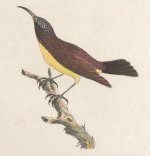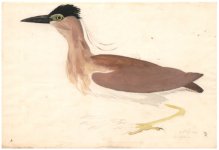Björn Bergenholtz
(former alias "Calalp")

I also have some questions regarding other synonyms (as well, all eponyms, all commemorating Swedish guys) ... this as there are similar, different bids or contradictory claims (alt. different opinions) in various references.
So what about ...
solanderi as in:
• "P. [Pseudoprion] turtur solanderi" MATHEWS 1912 (here)... equal of; nominate Pachyptila t. turtur KUHL 1820 or monotypic P. belcheri MATHEWS 1912 ... ?
sparrmannii as in:
• "A. [Ardea] Sparrmannii" WAGLER 1827 (here)... equal of; nominate Nycticorax caledonicus caledonicus GMELIN 1789 or Nycticorax caledonicus australasiae VIEILLOT 1823 ... ?
And the even more unknown (!) ...
sparrmannii as in:
• "C. [Certhia] Sparrmanni" SUCKOW 1800 (here)* ... based on Sparrman's "Certhia lepida" 1787, here (which, as I understand it, isn´t the same bird as "Certhia lepida" LATHAM 1790, the latter a synonym for Anthreptes malacensis SCOPOLI 1786?)
Is it a specimen of (Nectarinia) Leptocoma zeylonica LINNAEUS 1766 (here) as "[Certhia] "zeylonica"? Or yet another, completely different Sunbird... ?
I assume it has nothing to do with Linnaeus's "[Fringilla] lepida", also of 1766 (here).
Anyone who does know their Sunbirds?
Björn
______________________________________________
* from what I can tell, not listed in today's HBW Alive Key.
So what about ...
solanderi as in:
• "P. [Pseudoprion] turtur solanderi" MATHEWS 1912 (here)... equal of; nominate Pachyptila t. turtur KUHL 1820 or monotypic P. belcheri MATHEWS 1912 ... ?
sparrmannii as in:
• "A. [Ardea] Sparrmannii" WAGLER 1827 (here)... equal of; nominate Nycticorax caledonicus caledonicus GMELIN 1789 or Nycticorax caledonicus australasiae VIEILLOT 1823 ... ?
And the even more unknown (!) ...
sparrmannii as in:
• "C. [Certhia] Sparrmanni" SUCKOW 1800 (here)* ... based on Sparrman's "Certhia lepida" 1787, here (which, as I understand it, isn´t the same bird as "Certhia lepida" LATHAM 1790, the latter a synonym for Anthreptes malacensis SCOPOLI 1786?)
Is it a specimen of (Nectarinia) Leptocoma zeylonica LINNAEUS 1766 (here) as "[Certhia] "zeylonica"? Or yet another, completely different Sunbird... ?
I assume it has nothing to do with Linnaeus's "[Fringilla] lepida", also of 1766 (here).
Anyone who does know their Sunbirds?
Björn
______________________________________________
* from what I can tell, not listed in today's HBW Alive Key.






